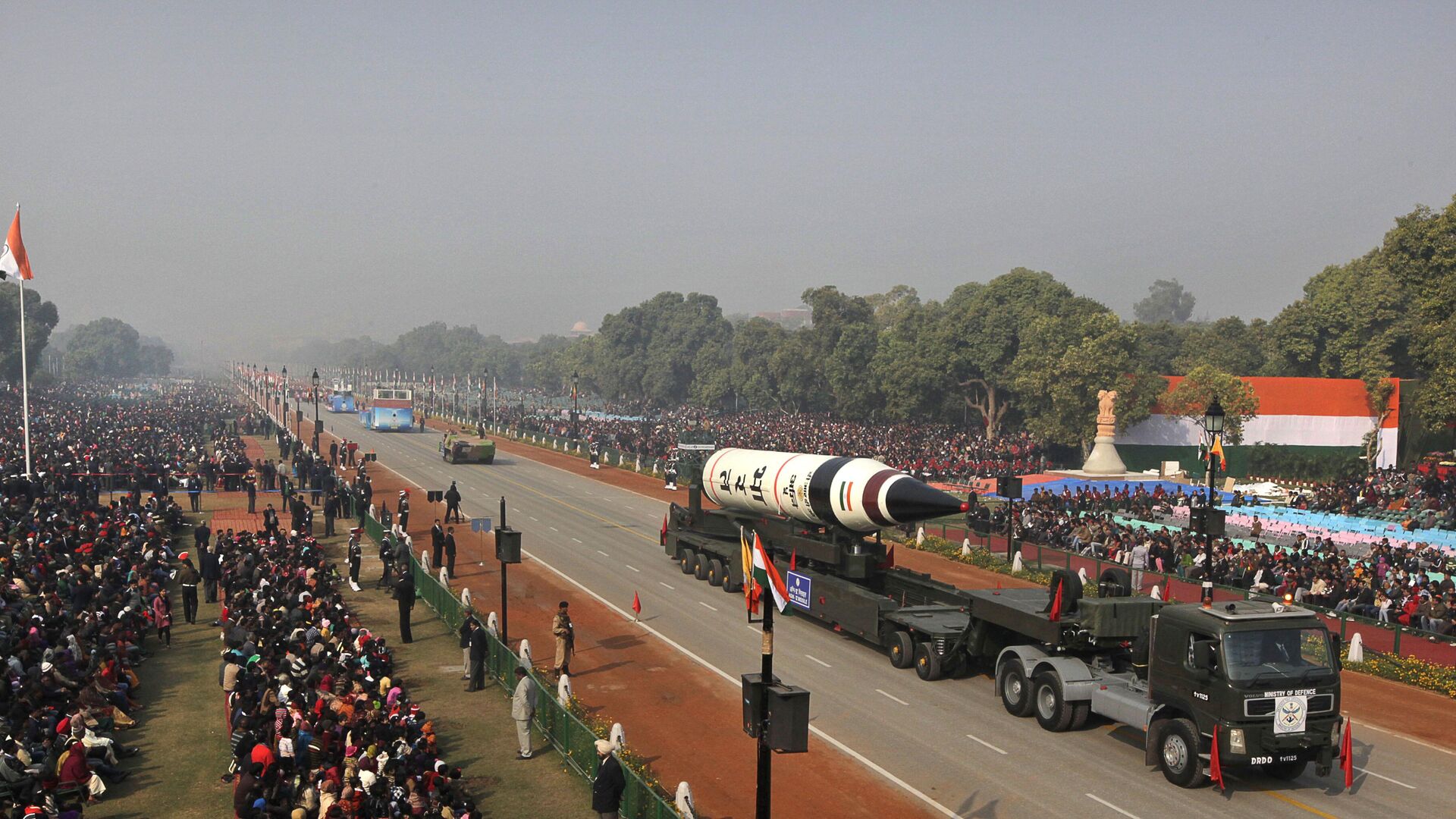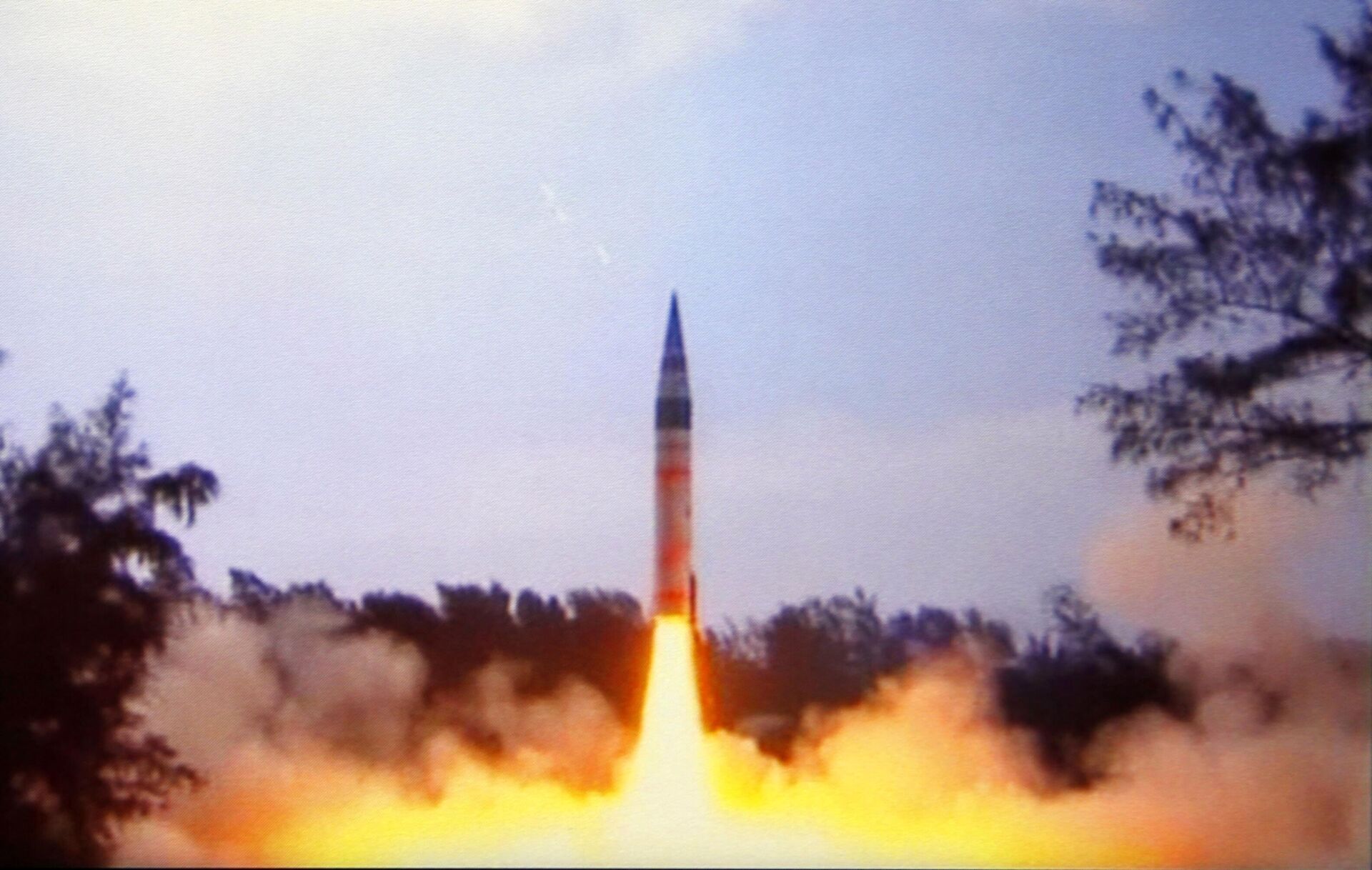https://sputniknews.in/20240312/how-indias-agni-v-icbm-becomes-nuclear-deterrence-game-changer-6810791.html
How India's Agni-V ICBM Becomes Nuclear Deterrence Game Changer
How India's Agni-V ICBM Becomes Nuclear Deterrence Game Changer
Sputnik India
India's latest test of an Agni-V missile, having MIRV capabilities will take the South Asian nation's nuclear deterrence capability to the next level, a military veteran has said.
2024-03-12T18:59+0530
2024-03-12T18:59+0530
2024-03-12T20:29+0530
sputnik opinion
narendra modi
india
pakistan
china
indian air force (iaf)
missiles
intercontinental ballistic missile (icbm)
military spending
defense sector
https://cdn1.img.sputniknews.in/img/07e8/03/0c/6813330_229:0:3852:2038_1920x0_80_0_0_1cc59ce9d9fc2b7158102ff173ceff5d.jpg
India's latest test of the Agni-V intercontinental ballistic missile (ICBM), having MIRV capabilities will take the South Asian nation's nuclear deterrence capability to the next level, a military veteran has said.The comments by Air Marshal (Retd) M. Matheswaran came only hours after Prime Minister Narendra Modi praised scientists from the Defence Research and Development Organisation (DRDO) for the MIRV's successful launch, which is being viewed as a game-changer for the security of the world's largest democratic state.In this context, Matheswaran explains that being a nuclear weapon state serves as a deterrent against adversaries attempting to coerce a nation using nuclear weapons.India's No-First-Use Nuclear Policy Demands Credible Second-Strike CapabilityThe retired IAF officer emphasized that India's nuclear deterrence policy is centred around a no-first-use principle, which requires a highly credible second-strike capability to be displayed.He believes that the MIRV technology is crucial because India should not rely on a single missile attack, particularly when it would require multiple missiles strategically placed across different locations. With MIRV capabilities, just one missile from India would be able to target and engage with 4-5, or even up to 10, different targets simultaneously.The Russian, American, and Chinese MIRVs carry 10 missiles each and that is the kind of capability they have, the defence expert stressed.MIRV Adds Muscle to India's Offensive Might Against Its EnemiesThe retired military officer empahsised that it is the right path that India has embarked on. This is all gradually progressing towards multiple capabilities. India Eyes 12,000-KM Range ICBMAccording to his assessment, the Agni-V boasts a range of over 5,000 kilometres. India must now strive towards developing an Inter-Continental Ballistic Missile with a range of 12,000 kilometres, capable of reaching any location on the planet.Also, Matheswaran spoke about the possible ramifications of India's maiden MIRV test vis-a-vis Pakistan. He noted that Pakistan does not have a no-first-use policy as far as nuclear weapons are concerned.The Pakistan Factor in India's MIRV TestMatheswaran explained that they have publicly declared their intent to use nuclear weapons if their survival is at risk. In such a scenario, prioritising a first-use policy means that Multiple Independently Targetable Reentry Vehicle (MIRV) capability is not as critical as other components that must be developed for first-use purposes.Matheswaran assessed that due to Pakistan's strategic partnership with China, they may not be interested in pursuing a Multiple Independently Targetable Reentry Vehicle (MIRV) system. Instead, they are more likely to focus on developing tactical nuclear weapons, missiles, and a sea-based deterrent, as they have not yet developed one.
https://sputniknews.in/20240311/indias-indigenously-developed-agni-5-missile-makes-first-flight-test-6802283.html
india
pakistan
china
south asia
Sputnik India
feedback.hindi@sputniknews.com
+74956456601
MIA „Rossiya Segodnya“
2024
Pawan Atri
https://cdn1.img.sputniknews.in/img/07e6/0c/13/139630_147:0:831:684_100x100_80_0_0_8fa2b25903e7787fe6a2698552c167df.png
Pawan Atri
https://cdn1.img.sputniknews.in/img/07e6/0c/13/139630_147:0:831:684_100x100_80_0_0_8fa2b25903e7787fe6a2698552c167df.png
News
en_IN
Sputnik India
feedback.hindi@sputniknews.com
+74956456601
MIA „Rossiya Segodnya“
Sputnik India
feedback.hindi@sputniknews.com
+74956456601
MIA „Rossiya Segodnya“
Pawan Atri
https://cdn1.img.sputniknews.in/img/07e6/0c/13/139630_147:0:831:684_100x100_80_0_0_8fa2b25903e7787fe6a2698552c167df.png
mirv technology india, agni-v test, agni-v icbm, indigenously developed agni-5 missile, agni-5 missile, intercontinental ballistic missile, icbm, mission divyastra, first flight test, multiple independently targetable re-entry vehicle, mirv, prime minister narendra modi, defence research and development organisation (drdo), scientists, avionics systems, sensor packages, india's weapons program, air marshal m. matheswaran,
mirv technology india, agni-v test, agni-v icbm, indigenously developed agni-5 missile, agni-5 missile, intercontinental ballistic missile, icbm, mission divyastra, first flight test, multiple independently targetable re-entry vehicle, mirv, prime minister narendra modi, defence research and development organisation (drdo), scientists, avionics systems, sensor packages, india's weapons program, air marshal m. matheswaran,
How India's Agni-V ICBM Becomes Nuclear Deterrence Game Changer
18:59 12.03.2024 (Updated: 20:29 12.03.2024) Earlier this week, India joined a select band of nations, including Russia, China, and the US, to have a Multiple Independently Targetable Re-entry Vehicle (MIRV) technology. Sputnik India examines how this successful test could be a game-changer for New Delhi.
India's latest test of the Agni-V intercontinental ballistic missile (ICBM), having MIRV capabilities will take the South Asian nation's nuclear deterrence capability to the next level, a military veteran has said.
The comments by
Air Marshal (Retd) M. Matheswaran came only hours after Prime Minister
Narendra Modi praised scientists from the
Defence Research and Development Organisation (DRDO) for the MIRV's successful launch, which is being viewed as a game-changer for the security of the world's largest democratic state.
In this context, Matheswaran explains that being a nuclear weapon state serves as a deterrent against adversaries attempting to coerce a
nation using nuclear weapons.
India's No-First-Use Nuclear Policy Demands Credible Second-Strike Capability
The retired
IAF officer emphasized that India's nuclear deterrence policy is centred around a no-first-use principle, which requires a highly credible second-strike capability to be displayed.
"Obviously, when one looks at the country's nuclear doctrine if anyone attacks India, its forces, or its assets inside its territory or even outside, it would retaliate with massive force and when one is talking about massive retaliation, one needs very large capabilities," Matheswaran told Sputnik India on Tuesday.
He believes that the MIRV technology is crucial because India should not rely on a single missile attack, particularly when it would require multiple missiles strategically placed across different locations. With MIRV capabilities, just one missile from India would be able to target and engage with 4-5, or even up to 10, different targets simultaneously.
The Russian, American, and Chinese MIRVs carry 10 missiles each and
that is the kind of capability they have, the defence expert stressed.
MIRV Adds Muscle to India's Offensive Might Against Its Enemies
"This is literally like attacking with independent nuclear weapons on each target but one is launching it through a single missile and then at a certain point in time these independently targeted re-entry vehicles, peel off and then attack different targets in a range of 200 to 500 kilometers from the point that which they separate themselves. This means, one's ability to attack increases manifold, which is a very strategic capability to be demonstrated," he added.
The retired military officer empahsised that it is the right path that India has embarked on. This is all gradually progressing towards multiple capabilities.
"I presume this is the first test of the MIRV, and there are a series of many more tests that will have to be done to perfect the whole process, and as I understand this is for four or five targets. Although, no official announcement is there that is the premise and the next step will be to increase the number," the geopolitics analyst, who serves as the president of Chennai-based think-tank, The Peninsula Foundation, highlighted.
India Eyes 12,000-KM Range ICBM
According to his assessment, the Agni-V boasts a range of over 5,000 kilometres. India must now strive towards developing an Inter-Continental Ballistic Missile with a range of 12,000 kilometres, capable of reaching any location on the planet.
Also, Matheswaran spoke about the possible ramifications of India's maiden MIRV test
vis-a-vis Pakistan.
He noted that Pakistan does not have a no-first-use policy as far as nuclear weapons are concerned.
The Pakistan Factor in India's MIRV Test
Matheswaran explained that they have publicly declared their intent to use nuclear weapons if their survival is at risk. In such a scenario, prioritising a first-use policy means that Multiple Independently Targetable Reentry Vehicle (MIRV) capability is not as critical as other components that must be developed for first-use purposes.
"Technology-wise, I think the MIRV is more complex and I don't think Pakistan has that capability. Pakistan's nuclear capability itself has come with China's assistance and indirect American help to a large extent. While they may have developed indigenous capabilities significantly after that, MIRV is still a far-fetched game for them," he opined.
Matheswaran assessed that due to Pakistan's strategic partnership with China, they may not be interested in pursuing a Multiple Independently Targetable Reentry Vehicle (MIRV) system. Instead, they are more likely to focus on developing tactical nuclear weapons, missiles, and a sea-based deterrent, as they have not yet developed one.




